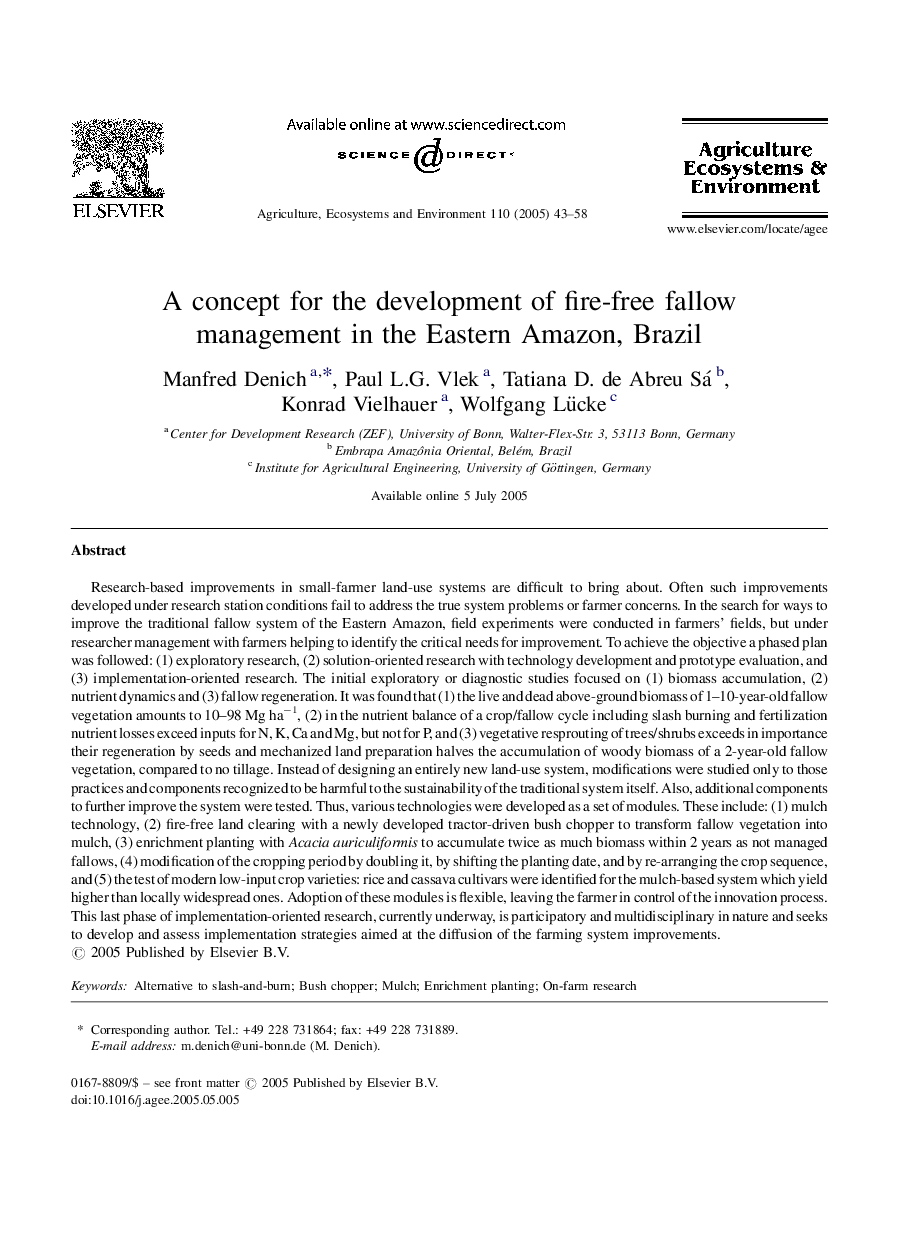| کد مقاله | کد نشریه | سال انتشار | مقاله انگلیسی | نسخه تمام متن |
|---|---|---|---|---|
| 8970770 | 1552154 | 2005 | 16 صفحه PDF | دانلود رایگان |
عنوان انگلیسی مقاله ISI
A concept for the development of fire-free fallow management in the Eastern Amazon, Brazil
دانلود مقاله + سفارش ترجمه
دانلود مقاله ISI انگلیسی
رایگان برای ایرانیان
موضوعات مرتبط
علوم زیستی و بیوفناوری
علوم کشاورزی و بیولوژیک
علوم زراعت و اصلاح نباتات
پیش نمایش صفحه اول مقاله

چکیده انگلیسی
Research-based improvements in small-farmer land-use systems are difficult to bring about. Often such improvements developed under research station conditions fail to address the true system problems or farmer concerns. In the search for ways to improve the traditional fallow system of the Eastern Amazon, field experiments were conducted in farmers' fields, but under researcher management with farmers helping to identify the critical needs for improvement. To achieve the objective a phased plan was followed: (1) exploratory research, (2) solution-oriented research with technology development and prototype evaluation, and (3) implementation-oriented research. The initial exploratory or diagnostic studies focused on (1) biomass accumulation, (2) nutrient dynamics and (3) fallow regeneration. It was found that (1) the live and dead above-ground biomass of 1-10-year-old fallow vegetation amounts to 10-98 Mg haâ1, (2) in the nutrient balance of a crop/fallow cycle including slash burning and fertilization nutrient losses exceed inputs for N, K, Ca and Mg, but not for P, and (3) vegetative resprouting of trees/shrubs exceeds in importance their regeneration by seeds and mechanized land preparation halves the accumulation of woody biomass of a 2-year-old fallow vegetation, compared to no tillage. Instead of designing an entirely new land-use system, modifications were studied only to those practices and components recognized to be harmful to the sustainability of the traditional system itself. Also, additional components to further improve the system were tested. Thus, various technologies were developed as a set of modules. These include: (1) mulch technology, (2) fire-free land clearing with a newly developed tractor-driven bush chopper to transform fallow vegetation into mulch, (3) enrichment planting with Acacia auriculiformis to accumulate twice as much biomass within 2 years as not managed fallows, (4) modification of the cropping period by doubling it, by shifting the planting date, and by re-arranging the crop sequence, and (5) the test of modern low-input crop varieties: rice and cassava cultivars were identified for the mulch-based system which yield higher than locally widespread ones. Adoption of these modules is flexible, leaving the farmer in control of the innovation process. This last phase of implementation-oriented research, currently underway, is participatory and multidisciplinary in nature and seeks to develop and assess implementation strategies aimed at the diffusion of the farming system improvements.
ناشر
Database: Elsevier - ScienceDirect (ساینس دایرکت)
Journal: Agriculture, Ecosystems & Environment - Volume 110, Issues 1â2, 1 October 2005, Pages 43-58
Journal: Agriculture, Ecosystems & Environment - Volume 110, Issues 1â2, 1 October 2005, Pages 43-58
نویسندگان
Manfred Denich, Paul L.G. Vlek, Tatiana D. de Abreu Sá, Konrad Vielhauer, Wolfgang Lücke,